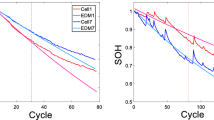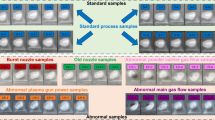A study was performed of the problem of increasing the measurement precision of the flow rate of fluids and gases by differential-pressure flow meters. Modeling of the discharge coefficient of an orifice plate of differential-pressure flow meters by machine learning methods was examined. It was shown that existing models of the discharge coefficient of an orifice plate are complex, and the values of the coefficients must be made more precise in the process of flow meter use. It is proposed to use, for the discharge coefficient of an orifice plate, a model based on a support vector machine. The structure and training process of the model are described, and the training parameters are specified. The modeling results obtained in training and testing the model are given, and its effectiveness was confirmed. A comparative analysis was performed of the proposed model based on a support vector machine and the existing model in the form of the Reader- Harris–Gallagher empirical equation. It is shown that the proposed model of the discharge coefficient is not inferior to the precision and effectiveness of the working model, and this makes it possible to improve systems for measuring the flow rate of fluids and gases. The results of the study will be useful for operations in the fields of production, transport, and storage of natural gas.




Similar content being viewed by others
References
J. Yoder, “Measuring a 1% obtain in a 4.5 billion dollars market”, FlowControl, 6, 42–45 (2008).
Zh. A. Daev, “Comparative analysis of the discharge coefficients of flow meters with variable pressure drop,” Metrologiya, No. 1, 32–36 (2015).
M. Reader-Harris, Orifice Plates and Venturi Tubes, Springer Switzerland, Glasgow (2015), https://doi.org/10.1007/978-3-319-16880-7.
D. E. Cristancho, K. R. Hall, L. A. Coy, and G. A. Iglesias-Silva, Flow Measur. Instrum., 21, No. 3, 299–301 (2010), https://doi.org/10.1016/j.flowmeasinst.2010.03.003.
J. A. Stolz, “Universal equation for the calculation of discharge coefficient of orifice plates,” in Proc. FLOMEKO 1978. IMEKO-Conference on Flow Measurement of Fluids, Groningen, Netherlands, Sept. 11–15, 1978, North-Holland, Amsterdam (1978), pp. 519–534.
M. J. Reader-Harris and J. A. Sattary, Flow Measus. Instrum., 1, No. 2, 67–76 (1990), https://doi.org/10.1016/0955-5986(90)90031-2.
M. J. Reader-Harris, J. A. Sattary, and E. R. Spearman, The Orifice Plate Discharge Coefficient Equation, Progress Report No. PR14. EUEC/17 (EEC005), National Engineering Laboratory Executive Agency, East Kilbride, Glasgow (1992).
M. J. Reader-Harris, J. A. Sattary, and E. R. Spearman, Flow Measur. Instrum., 6. No. 2, 101–114 (1995), https://doi.org/10.1016/0955-5986(94)00001-0.
M. J. Reader-Harris, C. Forsyth C., and T. Boussouara, Flow Measur. Instrum., 82, 102043 (2021), https://doi.org/10.1016/j.flowmeasinst.2021.102043.
E. N. Ahmed and A. A. Ghanem, Flow Measur. Instrum., 73. 101751 (2020), https://doi.org/10.1016/j.flowmeasinst.2020.101751.
C. L. Hollingshead, M. C. Johnson, S. L. Barfuss, and R. E. Spall, J. Petrol. Sci. Eng., 78, No. 3–4, 559–566 (2011), https://doi.org/10.1016/j.petrol.2011.08.008.
Zh. A. Dayev, Flow Measur. Instrum., 71, 101674 (2020), https://doi.org/10.1016/j.flowmeasinst.2019.101674.
Zh. Dayev and A. K. Kairakbaev, Appl. Artif. Intell., 35, 1128–1146 (2021), https://doi.org/10.1080/08839514.2021.1975378.
Zh. Dayev, A. Kairakbaev, K. Yetilmezsoy, et al., Flow Measur. Instrum., 79, 101913 (2021), https://doi.org/10.1016/j.flowmeasinst.2021.101913 (2021).
Zh. A. Dayev and L. N. Latyshev, Flow Measur. Instrum., 56, 18–22 (2017), https://doi.org/10.1016/j.flowmeasinst.2017.07.001.
S. Haykin, Neural Networks, A Comprehensive Foundation, Prentice Hall (1999).
J. G. Jarushkina, Foundations of Imprecise and Hybrid Systems, Finansy i Statistika, Moscow (2009).
D. Borg, M. Suetake, and D. Brandao, Flow Measur. Instrum., 40, 142–148 (2014), https://doi.org/10.1016/j.flowmeasinst.2014.09.007
Author information
Authors and Affiliations
Corresponding author
Additional information
Translated from Izmeritel’naya Tekhnika, No. 4, pp. 37–42, April, 2022.
Rights and permissions
Springer Nature or its licensor (e.g. a society or other partner) holds exclusive rights to this article under a publishing agreement with the author(s) or other rightsholder(s); author self-archiving of the accepted manuscript version of this article is solely governed by the terms of such publishing agreement and applicable law.
About this article
Cite this article
Dayev, Z.A., Shopanova, G.E. Modelling of the Discharge Coefficient of Differential Pressure Flowmeters by the Support Vector Machine. Meas Tech 65, 266–272 (2022). https://doi.org/10.1007/s11018-022-02078-5
Received:
Accepted:
Published:
Issue Date:
DOI: https://doi.org/10.1007/s11018-022-02078-5




